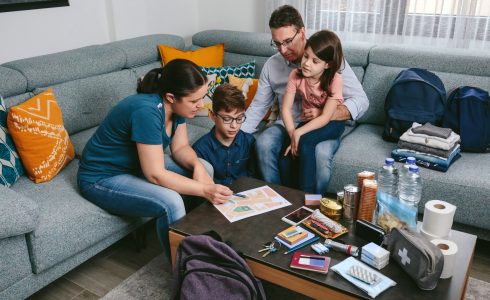
The time to prepare for a natural disaster is when the skies are clear. Planning ahead and knowing what to do will make your family feel more confident in the rare event of an emergency. Here’s what to do to create a disaster preparedness plan for your family and home.
Start with a plan
A clearly outlined plan is crucial for safety. It will help mitigate the effects of stress and uncertainties that occur during emergencies. Start by identifying the common types of disasters that are common in your area. For the Bay Area, that’s typically wildfire, earthquakes, and sometimes flooding. Talk about the types of natural disasters that happen in your area and the respective safety procedures. Take time to review the exit routes outside your home as well.
Establish a meeting place near your home for your family to gather in case you become separated or unable to return to the house, like a friend’s home or community shelter area. Be mindful and plan for any special accommodations you may need for elderly or disabled family members.
Create a list of emergency contacts and make sure everyone has the information (it’s also helpful to program that information into your phone). Plan evacuation routes from your home and neighborhood, including alternate routes in case of road closures.
All adults and teenage family members should know where the water, gas, and electrical lines are and how to turn them to off if directed by officials. This will be important if you receive an evacuation order. Keep necessary tools nearby and make sure everyone knows where they are.
Finally, don’t forget about your pets! Because not all shelters accept pets, it’s important to make a plan in advance. Figure out which shelters accept pets and make sure your pets are microchipped and have ID tags with your contact information.
Create an emergency supply kit
A basic disaster supply kit is meant to sustain your family for about 3 days without electricity and basic services. Store this kit in a large waterproof container in an easily accessible area so you can quickly grab it and leave. Here are some things you should have in your disaster supplies kit:
- Drinking water (at least one gallon per person per day)
- Nonperishable food, including pet and infant supplies if necessary
- First-aid kit
- Medications
- Battery-operated radio
- Flashlight and extra batteries
- External battery/charging bricks for mobile devices
Check out Ready.gov for more information on what to pack in your emergency kit.
Gather and secure important documents
Having crucial documents makes rebuilding following a disaster smoother. Take time to gather important documents, like bank information, insurance policies (home, vehicle, and any other relevant policies you’ve purchased), and medical information. It’s also a good idea to create an inventory of your possessions, either through photos or a written list, including any receipt and warranty information. You can place this information in a fireproof safe at home or a safe deposit box in another location.
Having a digital version of this information is helpful as well. Consider adding digital versions of marriage and birth certificates, wills, deeds, and passports to this cache.
While we can’t predict or prevent natural disasters, being prepared for them will help you keep yourself, your family, and your home safe. We recommend checking out other helpful national resources like the American Red Cross, FEMA, and Ready.gov for additional information.

